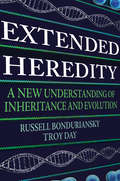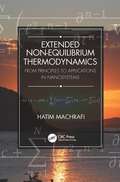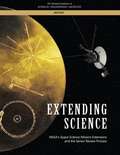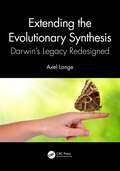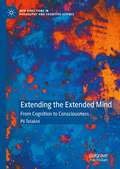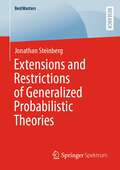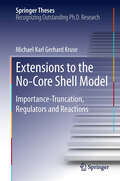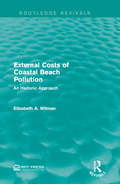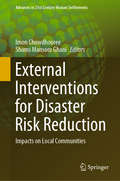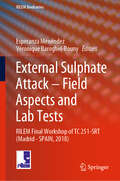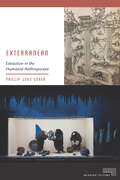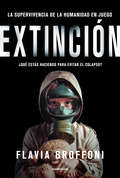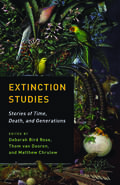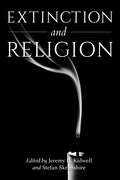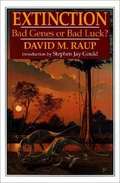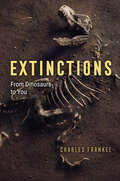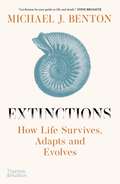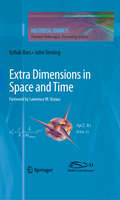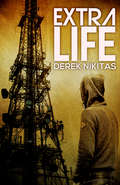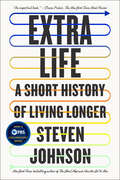- Table View
- List View
Extended Heredity: A New Understanding of Inheritance and Evolution
by Troy Day Russell BondurianskyHow genes are not the only basis of heredity—and what this means for evolution, human life, and diseaseFor much of the twentieth century it was assumed that genes alone mediate the transmission of biological information across generations and provide the raw material for natural selection. In Extended Heredity, leading evolutionary biologists Russell Bonduriansky and Troy Day challenge this premise. Drawing on the latest research, they demonstrate that what happens during our lifetimes--and even our grandparents' and great-grandparents' lifetimes—can influence the features of our descendants. On the basis of these discoveries, Bonduriansky and Day develop an extended concept of heredity that upends ideas about how traits can and cannot be transmitted across generations. By examining the history of the gene-centered view in modern biology and reassessing fundamental tenets of evolutionary theory, Bonduriansky and Day show that nongenetic inheritance—involving epigenetic, environmental, behavioral, and cultural factors—could play an important role in evolution. The discovery of nongenetic inheritance therefore has major implications for key questions in evolutionary biology, as well as human health.Extended Heredity reappraises long-held ideas and opens the door to a new understanding of inheritance and evolution.
Extended Non-Equilibrium Thermodynamics: From Principles to Applications in Nanosystems
by Hatim MachrafiExtended Non-Equilibrium Thermodynamics provides powerful tools departing not from empirical or statistical considerations but from fundamental thermodynamic laws, proposing final solutions that are readily usable and recognizable for students, researchers and industry. The book deals with methods that allow combining easily the present theory with other fields of science, such as fluid and solid mechanics, heat and mass transfer processes, electricity and thermoelectricity, and so on. Not only are such combinations facilitated, but they are incorporated into the developments in such a way that they become part of the theory. This book aims at providing for a systematic presentation of Extended Non-Equilibrium Thermodynamics in nanosystems with a high degree of applicability. Furthermore, the book deals with how physical properties of systems behave as a function of their size. Moreover, it provides for a systematic approach to understand the behavior of thermal, electrical, thermoelectric, photovoltaic and nanofluid properties in nanosystems. Experimental results are used to validate the theory, the comparison is analysed, justified and discussed, and the theory is then again used to understand better experimental observations. The new developments in this book, being recognizable in relation with familiar concepts, should make it appealing for academics and researchers to teach and apply and graduate students to use. The text in this book is intended to bring attention to how the theory can be applied to real-life applications in nanoscaled environments. Case studies, and applications of theories, are explored including thereby nanoporous systems, solar panels, nanomedicine drug permeation and properties of nanoporous scaffolds. Explores new generalized thermodynamic models Provides introductory context of Extended Non-Equilibrium Thermodynamics within classical thermodynamics, theoretical fundamentals and several applications in nanosystems Provides for a systematic approach to understand the behavior of thermal, electric, thermoelectric and viscous properties as a function of several parameters in nanosystems Includes reflections to encourage the reader to think further and put the information into context Examines future developments of new constitutive equations and theories and places them in the framework of real-life applications in the energetic and medical sectors, such as photovoltaic and thermoelectric devices, nanoporous media, drug delivery and scaffolds
Extended Reality Solutions to Support Older Adults: Potential Applications for Users With and Without Cognitive Impairments (Synthesis Lectures on Technology and Health)
by Sara J. Czaja Walter R. Boot Andrew Dilanchian Saleh KalantariThis book explores one way in which recent hardware and software advances have placed humanity on the precipice of a significant shift in how technology can shape our interactions with the world around us: the application of transformative extended reality (XR) technology solutions to support the health, wellness, quality of life, and independence of older adults living with and without cognitive impairments. The book provides an overview of the state-of-the art research on XR-based solutions utilizing virtual reality (VR) and augmented reality (AR), challenges that can addressed with these technologies, evidence to date on the efficacy of these solutions, and the nature of these solutions and challenges to their implementation. It explores practical ways XR can be integrated into health and lifestyle maintenance activities for older populations in a diversity of situations through thematic chapters using realistic personas and scenarios. These thematic chapters are organized around the AGE-WELL Challenge Area topics, including staying connected, healthy lifestyles and wellness, mobility, and cognitive health, as well as an additional emphasis on leisure. Other chapters provide guidance on important issues to consider when designing XR-based solutions for older adults, how to evaluate and test XR solutions, the implementation of the user-centered design process, and the book concludes by highlighting unanswered questions and future research directions. This book approaches XR for older adults with and without cognitive impairments from the authors’ diverse research backgrounds in psychology, engineering, gerontology, and design. It will be of interest to academic and industry professionals as well as care providers considering the potential for XR interventions now and in the future.
Extending Science: Nasa's Space Science Mission Extensions And The Senior Review Process
by Engineering Medicine National Academies of SciencesNASA operates a large number of space science missions, approximately three-quarters of which are currently in their extended operations phase. They represent not only a majority of operational space science missions, but a substantial national investment and vital national assets. They are tremendously scientifically productive, making many of the major discoveries that are reported in the media and that rewrite textbooks. Extending Science – NASA's Space Science Mission Extensions and the Senior Review Process evaluates the scientific benefits of missions extensions, the current process for extending missions, the current biennial requirement for mission extensions, the balance between starting new missions and extending operating missions, and potential innovative cost-reduction proposals for extended missions, and makes recommendations based on this review.
Extending the Evolutionary Synthesis: Darwin’s Legacy Redesigned
by Axel LangeThe theory of evolution is itself evolving with new findings and changes in the fundamental underlying concepts. It is true that today's synthetic theory, which goes back to Darwin, is persistently successful. However, it offers no convincing explanation to many questions, some examples of which are as follows: What forms of inheritance exist besides genetics; how complex variations, especially evolutionary innovations such as bird feathers and turtle shells, arise; how the environment affects the evolution of species and is changed by them simultaneously; and why the evolution of birds, corals, and human culture is not explainable by natural selection alone. Scientific findings of the last decades require continuous rethinking and integration of new data and concepts into the theory of evolution. This comprehensibly written and excellently researched book provides exciting new insights into the Extended Evolutionary Synthesis using fascinating new examples from evolutionary biology. Key Features Comprehensively explains the Extended Evolutionary Synthesis Understandably written for a broad audience Includes interviews with world-leading evolutionary biologists Reviews the historical development of evolutionary theory with explanations of open, unanswered questions Explains the new concepts with powerful illustrations Related Titles Bard, J. Evolution: The Origins and Mechanisms of Diversity (ISBN 9781032138480) Johnson, N. Darwin’s Reach: 21st Century Applications of Evolutionary Biology (ISBN 9781138587427)
Extending the Extended Mind: From Cognition to Consciousness (New Directions in Philosophy and Cognitive Science)
by Pii TelakiviThis book argues that conscious experience is sometimes extended outside the brain and body into certain kinds of environmental interaction and tool use. It shows that if one accepts that cognitive states can extend, one must also accept that consciousness can extend. The proponents of Extended Mind defend the former claim, but usually oppose the latter claim. The most important undertaking of this book is to show that this partition is not possible on pain of inconsistency. Pii Telakivi presents three arguments for the hypothesis of Extended Conscious Mind, examines and answers the most common counterarguments, and introduces a novel means to interpret and apply the concept of constitution. She also addresses the tensions between analytic philosophy of mind and enactivism, and builds a bridge between two different traditions: on the one hand, extended mind, and on the other, enactivism and embodied mind—and maintains that a unifying approach is necessary for a theory about extended consciousness.
Extensions and Restrictions of Generalized Probabilistic Theories (BestMasters)
by Jonathan SteinbergGeneralized probabilistic theories (GPTs) allow us to write quantum theory in a purely operational language and enable us to formulate other, vastly different theories. As it turns out, there is no canonical way to integrate the notion of subsystems within the framework of convex operational theories. Sections can be seen as generalization of subsystems and describe situations where not all possible observables can be implemented. Jonathan Steinberg discusses the mathematical foundations of GPTs using the language of Archimedean order unit spaces and investigates the algebraic nature of sections. This includes an analysis of the category theoretic structure and the transformation properties of the state space. Since the Hilbert space formulation of quantum mechanics uses tensor products to describe subsystems, he shows how one can interpret the tensor product as a special type of a section. In addition he applies this concept to quantum theory and compares it with the formulation in the algebraic approach. Afterwards he gives a complete characterization of low dimensional sections of arbitrary quantum systems using the theory of matrix pencils.
Extensions of f: Curvature-Matter Couplings and Hybrid Metric-Palatini Theory (Cambridge Monographs on Mathematical Physics #1)
by Francisco S. Lobo Tiberiu HarkoRecent cosmological observations have posed a challenge for traditional theories of gravity: what is the force driving the accelerated expansion of the universe? What if dark energy or dark matter do not exist and what we observe is a modification of the gravitational interaction that dominates the universe at large scales? Various extensions to Einstein's General Theory of Relativity have been proposed, and this book presents a detailed theoretical and phenomenological analysis of several leading, modified theories of gravity. Theories with generalised curvature-matter couplings are first explored, followed by hybrid metric-Palatini gravity. This timely book first discusses key motivations behind the development of these modified gravitational theories, before presenting a detailed overview of their subsequent development, mathematical structure, and cosmological and astrophysical implications. Covering recent developments and with an emphasis on astrophysical and cosmological applications, this is the perfect text for graduate students and researchers.
Extensions to the No-Core Shell Model: Importance-Truncation, Regulators and Reactions
by Michael Karl KruseExtensions to the No-Core Shell Model presents three extensions to the No-Core Shell Model (NCSM) that allow for calculations of heavier nuclei, specifically for the p-shell nuclei. The Importance-Truncated NCSM (IT-NCSM) formulated on arguments of multi-configurational perturbation theory selects a small set of basis states from the initially large basis space in which the Hamiltonian is diagnolized. Previous IT-NCSM calculations have proven reliable, however, there has been no thorough investigation of the inherent error in the truncated IT-NCSM calculations. This thesis provides a detailed study of IT-NCSM calculations and compares them to full NCSM calculations to judge the accuracy of IT-NCSM in heavier nuclei. When IT-NCSM calculations are performed, one often needs to extrapolate the ground-state energy from the finite basis (or model) spaces to the full NCSM model space. In this thesis a careful investigation of the extrapolation procedures was performed. On a related note, extrapolations in the NCSM are commonplace, but up to recently did not have the ultraviolet (UV) or infrared (IR) physics under control. This work additionally presents a method that maps the NCSM parameters into an effective-field theory inspired framework, in which the UV and IR physics are treated appropriately. The NCSM is well-suited to describe bound-state properties of nuclei, but is not well-adapted to describe loosely bound systems, such as the exotic nuclei near the neutron drip line. With the inclusion of the Resonating Group Method (RGM), the NCSM / RGM can provide a first-principles description of exotic nuclei and the first extension of the NCSM.
External Costs of Coastal Beach Pollution: An Hedonic Approach (Routledge Revivals)
by Elizabeth A. WilmanIn this title, originally published in 1984, Wilman develops and describes a methodology for imputing a monetary value to the loss in beach recreational services that would result from a hypothetical oil spill in the Georges Bank area off Massachusetts. Combining an oil-spill risk analysis model with an hedonic pricing model to generate estimates of beach pollution costs associated with offshore oil development, Wilman makes possible for the first time a rational judgement regarding whether the benefits of developing offshore oil outweigh the costs. This book is a valuable resource for students interested in environmental studies and Wilman’s methodological approach can be used to value other nonmarket resource services in any area.
External Interventions for Disaster Risk Reduction: Impacts on Local Communities (Advances in 21st Century Human Settlements)
by Imon Chowdhooree Shams Mansoor GhaniThis book presents a case study-based analysis of the consequences of external interventions, critically evaluating them from community perspectives. Communities – from rural to urban, and around the world – that are experiencing disasters and changes in climatic variables can perceive the associated risks and evaluate the impacts of interventions. Accordingly, community perspectives, including their perceptions, concerns, awareness, realizations, reactions and expectations, represent a valuable resource. The case-based analysis of impacts on communities can provide a ‘means of learning’ from the experiences of others, thus expanding professionals’ knowledge base, especially regarding disaster mitigation and climate change adaptation practices in varied settings. This book offers valuable insights and lessons learned, in an effort to promote and guide innovative changes in the current planning, management and governance of human settlements, helping them face the future challenges of a changing environment.
External Sulphate Attack – Field Aspects and Lab Tests: RILEM Final Workshop of TC 251-SRT (Madrid - SPAIN, 2018) (RILEM Bookseries #21)
by Esperanza Menéndez Véronique Baroghel-BounyThis volume gathers contributions from the final workshop of the RILEM TC-251-SRT "Sulfate Resistance Testing" on External Sulfate Attack (TESA 2018), held on May 24-25, 2018 at IETcc-CSIC, Madrid, Spain. One of the Technical Committee’s main events, it addressed various aspects of external sulfate attack in concrete structures and test methods. The workshop promoted technical discussions and debates on ideas on these topics, with a focus on evaluating the resistance of concrete exposed to ESA. It also provided a forum for participants from around the globe to share their experiences and research on concrete structures affected by external sulfate attack and on test methods. The book discusses the latest advances in research related to ESA and new developments in test methods, and features real-world case studies of concrete structures affected by external sulfate attack in various countries. It also presents new studies linking field cases and lab tests, including 12 contributions on 3 main themes: mechanisms of alteration in external sulfate attack; field aspects of external sulfate attack; and testing to evaluate the resistance of concrete to external sulfate attack.
Exterranean: Extraction in the Humanist Anthropocene (Meaning Systems)
by Phillip John UsherExterranean concerns the extraction of stuff from the Earth, a process in which matter goes from being sub- to exterranean. By opening up a rich archive of nonmodern texts and images from across Europe, this work offers a bracing riposte to several critical trends in ecological thought. By shifting emphasis from emission to extraction, Usher reorients our perspective away from Earthrise-like globes and shows what is gained by opening the planet to depths within. The book thus maps the material and immaterial connections between the Earth from which we extract, the human and nonhuman agents of extraction, and the extracted matter with which we live daily.Eschewing the self-congratulatory claims of posthumanism, Usher instead elaborates a productive tension between the materially-situated homo of nonmodern humanism and the abstract and aggregated anthropos of the Anthropocene. In dialogue with Michel Serres, Bruno Latour, and other interdisciplinary work in the environmental humanities, Usher shows what premodern material can offer to contemporary theory. Examining textual and visual culture alike, Usher explores works by Ronsard, Montaigne, and Rabelais, early scientific works by Paracelsus and others, as well as objects, engravings, buildings, and the Salt Mines of Wieliczka. Both historicist and speculative in approach, Exterranean lays the groundwork for a comparative ecocriticism that reaches across and untranslates theoretical affordances between periods and languages.
Extinción: La supervivencia de la humanidad en juego. / ¿Qué estás haciendo para evitar el colapso?
by Flavia BroffoniLa información sobre la crisis ecológica y climática está al alcance de todos y en boca de nadie. Extinción nos revela toda la información que no sale en los medios hegemónicos de comunicación, y pone en evidencia la crisis planetaria en que nos encontramos. Este es un libro urgente para entender qué hay detrás de esta crisis. Desde las estrategias políticas, el agronegocio y los modelos educativos hasta las formas de consumo que nos parecen naturales, este libro cuenta con la fuerza suficiente para hacernos ver la realidad y comenzar a actuar conscientemente. Extinción nos revela con evidencia científica la crisis ecológica y climática que atraviesa nuestro planeta. En los próximos cincuenta años 4000 millones de personas vivirán en zonas no aptas para la producción de alimentos. Para 2080 América del Sur estará en una sequía extrema. El 60% de los mamíferos y el 70% de las aves son criados para alimentar humanos. Este año una pandemia puso en estado de emergencia a todo el mundo. El 60% de las enfermedades infecciosas son transmitidas por animales. Mientras, crece la población de animales industrializados en hábitats naturales destruidos y ecosistemas alterados. ¿Qué estamos haciendo para frenar este ecocidio? ¿Por qué esta información no está al alcance de todos? Flavia Broffoni propone darle batalla a la civilización que está arrasando con la naturaleza. Extinción es un libro urgente: quedan menos de diez años para detener el colapso. En palabras de la autora, "la decisión más honesta que podemos tomar en estos momentos de incertidumbre es qué hacer con el Tiempo que tenemos".
Extinct Madagascar: Picturing the Island's Past
by Steven M. Goodman William L. Jungers Velizar SimeonovskiThe landscapes of Madagascar have long delighted zoologists, who have discovered, in and among the island’s baobab trees and thickets, a dizzying array of animals, including something approaching one hundred species of lemur. Madagascar’s mammal fauna, for example, is far more diverse, and more endemic, than early explorers and naturalists ever dreamed of. But in the past 2,500 or so years—a period associated with natural climatic shifts and ecological change, as well as partially coinciding with the arrival of the island’s first human settlers—a considerable proportion of Madagascar’s forests have disappeared; and in the wake of this loss, a number of species unique to Madagascar have vanished forever into extinction. In Extinct Madagascar, noted scientists Steven M. Goodman and William L. Jungers explore the recent past of these land animal extinctions. Beginning with an introduction to the geologic and ecological history of Madagascar that provides context for the evolution, diversification, and, in some cases, rapid decline of the Malagasy fauna, Goodman and Jungers then seek to recapture these extinct mammals in their environs. Aided in their quest by artist Velizar Simeonovski’s beautiful and haunting digital paintings—images of both individual species and ecosystem assemblages reproduced here in full color—Goodman and Jungers reconstruct the lives of these lost animals and trace their relationships to those still living. Published in conjunction with an exhibition of Simeonovski’s artwork set to open at the Field Museum, Chicago, in the fall of 2014, Goodman and Jungers’s awe-inspiring book will serve not only as a sobering reminder of the very real threat of extinction, but also as a stunning tribute to Madagascar’s biodiversity and a catalyst for further research and conservation.
Extinction Studies: Stories of Time, Death, and Generations
by Thom Van Dooren Edited by Deborah Bird Rose Matthew ChrulewExtinction Studies focuses on the entangled ecological and social dimensions of extinction, exploring the ways in which extinction catastrophically interrupts life-giving processes of time, death, and generations. The volume opens up important philosophical questions about our place in, and obligations to, a more-than-human world. Drawing on fieldwork, philosophy, literature, history, and a range of other perspectives, each of the chapters in this book tells a unique extinction story that explores what extinction is, what it means, why it matters—and to whom.
Extinction and Religion (Religion and the Human)
by Timothy B. Leduc Catherine Keller Maria Nita Lisa H. Sideris Willis Jenkins Catherine Rigby James HatleyHuman-caused extinctions have never been so prominent in our political and cultural landscape. Extinction and Religion is a collection of wide-ranging chapters that explore the implications for religious faith and experience as it relates to a "sixth mass extinction" in Earth's history. Further it seeks to answer the question as to how religious and spiritual practices are shaping responses to the crisis?Edited by Jeremy H. Kidwell and Stefan Skrimshire, this collection aims to set a new postsecular agenda, articulating the questions, challenges, and ways forward for thinking about religion in an age of mass extinction rather than provide responses from world religions in isolation. It covers subjects such as the multitude of challenges posed by mass extinction to beliefs about the future of humanity, death and the afterlife, the integrity of creation, and the relationship between human and nonhuman life.Wide ranging and incisive, Extinction and Religion amply demonstrates the many ways in which the threat of extinction profoundly affects our faith and religious life worlds.
Extinction: Bad Genes or Bad Luck?
by David M. RaupPresents a comprehensive overview of the current state of extinction studies.
Extinctions: From Dinosaurs to You
by Charles FrankelA compelling answer to an important question: Can past mass extinctions teach us how to avoid future planetary disaster? On its face, the story of mass extinction on Earth is one of unavoidable disaster. Asteroid smashes into planet; goodbye dinosaurs. Planetwide crises seem to be beyond our ability to affect or evade. Extinctions argues that geological history tells an instructive story, one that offers important signs for us to consider. When the asteroid struck, Charles Frankel explains, it set off a wave of cataclysms that wore away at the global ecosystem until it all fell apart. What if there had been a way to slow or even turn back these tides? Frankel believes that the answer to this question holds the key to human survival. Human history, from the massacre of Ice Age megafauna to today’s industrial climate change, has brought the planet through another series of cataclysmic events. But the history of mass extinction together with the latest climate research, Frankel maintains, shows us a way out. If we curb our destructive habits, particularly our drive to kill and consume other species, and work instead to conserve what biodiversity remains, the Earth might yet recover. Rather than await decisive disaster, Frankel argues that we must instead take action to reimagine what it means to be human. As he eloquently explains, geological history reminds us that life is not eternal; we can disappear, or we can become something new and continue our evolutionary adventure.
Extinctions: How Life Survives, Adapts And Evolves
by Michael J. BentonA journey through the great mass extinction events that have shaped our Earth. This timely and original book lays out the latest scientific understanding of mass extinction on our planet. Cutting-edge techniques across biology, chemistry, physics, and geology have transformed our understanding of the deep past, including the discovery of a previously unknown mass extinction. This compelling evidence, revealing a series of environmental crises resulting in the near collapse of life on Earth, illuminates our current dilemmas in exquisite detail. Beginning with the oldest, Professor Michael J. Benton takes us through the “big five” die outs: the Late Ordovician, which set the evolution of the first animals on an entirely new course; the Late Devonian, apparently brought on by global warming; the cataclysmic End-Permian, also known as the Great Dying, which wiped out over 90 percent of alllife on Earth; the newly discovered Carnian Pluvial Event; and the End-Cretaceous asteroid. He examines how global warming, acid rain, ocean acidification, erupting volcanoes, and meteorite impact have affected conditions on Earth, and how life survived, adapted, and evolved. Benton’s expert retelling of scientific breakthroughs in paleobiology is illustrated throughout with photographs of fossils and fieldwork, and artistic reconstructions of ancient environments. In Extinctions, readers will learn about revolutionary new tools used to uncover ancient extinction events and processes in forensic detail, and how scientists are improving our understanding of the deep past. New research allows us to link long-ago upheavals to crises in our current age, the Anthropocene, with important consequences for us all.
Extinctions: Living and Dying in the Margin of Error
by Michael HannahAre we now entering a mass extinction event? What can mass extinctions in Earth's history tell us about the Anthropocene? What do mass extinction events look like and how does life on Earth recover from them? The fossil record reveals periods when biodiversity exploded, and short intervals when much of life was wiped out in mass extinction events. In comparison with these ancient events, today's biotic crisis hasn't (yet) reached the level of extinction to be called a mass extinction. But we are certainly in crisis, and current parallels with ancient mass extinction events are profound and deeply worrying. Humanity's actions are applying the same sorts of pressures - on similar scales - that in the past pushed the Earth system out of equilibrium and triggered mass extinction events. Analysis of the fossil record suggests that we still have some time to avert this disaster: but we must act now.
Extra Dimensions in Space and Time
by Lawrence Krauss John Terning Farzad Nekoogar Itzhak BarsIn physics, the idea of extra spatial dimensions originates from Nordstöm's 5-dimensional vector theory in 1914, followed by Kaluza-Klein theory in 1921, in an effort to unify general relativity and electromagnetism in a 5 dimensional space-time (4 dimensions for space and 1 for time). Kaluza-Klein theory didn't generate enough interest with physicist for the next five decades, due to its problems with inconsistencies. With the advent of supergravity theory (the theory that unifies general relativity and supersymmetry theories) in late 1970's and eventually, string theories (1980s) and M-theory (1990s), the dimensions of space-time increased to 11 (10-space and 1-time dimension). There are two main features in this book that differentiates it from other books written about extra dimensions: The first feature is the coverage of extra dimensions in time (Two Time physics), which has not been covered in earlier books about extra dimensions. All other books mainly cover extra spatial dimensions. The second feature deals with level of presentation. The material is presented in a non-technical language followed by additional sections (in the form of appendices or footnotes) that explain the basic equations and formulas in the theories. This feature is very attractive to readers who want to find out more about the theories involved beyond the basic description for a layperson. The text is designed for scientifically literate non-specialists who want to know the latest discoveries in theoretical physics in a non-technical language. Readers with basic undergraduate background in modern physics and quantum mechanics can easily understand the technical sections. Part I starts with an overview of the Standard Model of particles and forces, notions of Einstein's special and general relativity, and the overall view of the universe from the Big Bang to the present epoch, and covers Two-Time physics. 2T-physics has worked correctly at all scales of physics, both macroscopic and microscopic, for which there is experimental data so far. In addition to revealing hidden information even in familiar "everyday" physics, it also makes testable predictions in lesser known physics regimes that could be analyzed at the energy scales of the Large Hadron Collider at CERN or in cosmological observations." Part II of the book is focused on extra dimensions of space. It covers the following topics: The Popular View of Extra Dimensions, Einstein and the Fourth Dimension, Traditional Extra Dimensions, Einstein's Gravity, The Theory Formerly Known as String, Warped Extra Dimensions, and How Do We Look For Extra Dimensions?
Extra Life
by Derek NikitasRuss has never been your typical teen. After being expelled, Russ has started to get his life back on track. He's a pop culture junkie, and living in a town where the popular teen soap "Cape Twilight" is filmed, how could he not be? So when Russ decides to make his own short film, he recruits the (emotionally unhinged) star of "Cape Twilight" and his own motley crew to help out. Seems like a great idea...until the plan blows up in Russ's face.Just when everything seems to be falling apart, Russ receives a message on his cell phone - from himself. Recorded in the future, 'future Russ' informes him that the day can be fixed if he's willing to use an app to leap twelve hours into the past. Russ is happy to oblige, figuring the day can't get any worse. But he couldn't be more wrong. Because as soon as Russ tampers with time and space, he introduces dangerous glitches he can't control, including alternate of himself. And suddenly Russ's sanity and the lives of everyone he cares about are at risk if he can't find a way to regain control of his own life- past, present and future.
Extra Life (Young Readers Adaptation): The Astonishing Story of How We Doubled Our Lifespan
by Steven JohnsonA young readers adaptation of Steven Johnson's Extra Life, the story of how humans have doubled our lifespan in less than a century—and what to do with the extra life we now have.Humans live longer now than they ever have in their more than three hundred thousand years of existence on earth. And most (if not all) of the advances that have permitted the human lifespan to double have happened in living memory. Extra Life looks at vaccines, seat belts, pesticides, and more, and how each of our scientific advancements have prolonged human life. This book is a deep dive into the sciences--perfect for younger readers who enjoy modern history as well as scientific advances.
Extra Life: A Short History of Living Longer
by Steven JohnsonAs featured in The New York Times Magazine, and on an upcoming PBS documentary series: the surprising and important story of how humans gained what amounts to an extra life, from the bestselling author of How We Got to Now and Where Good Ideas Come From As a species we have doubled our life expectancy in just one hundred years. All the advances of modern life—the medical breakthroughs, the public health institutions, the rising standards of living—have given us each about twenty thousand extra days on average. There are few measures of human progress more astonishing than our increased longevity. This book is Steven Johnson&’s attempt to understand where that progress came from. How many of those extra twenty thousand days came from vaccines, or the decrease in famines, or seatbelts? What are the forces that now keep us alive longer? Behind each breakthrough lies an inspiring story of cooperative innovation, of brilliant thinkers bolstered by strong systems of public support and collaborative networks. But it is not enough simply to remind ourselves that progress is possible. How do we avoid decreases in life expectancy as our public health systems face unprecedented challenges? What current technologies or interventions that could reduce the impact of future crises are we somehow ignoring? A study in how meaningful change happens in society, Extra Life is an ode to the enduring power of common goals and public resources. The most fundamental progress we have experienced over the past few centuries has not come from big corporations or start-ups. It has come, instead, from activists struggling for reform; from university-based and publicly funded scientists sharing their findings open-source-style; and from nonprofit agencies spreading new innovations around the world.
